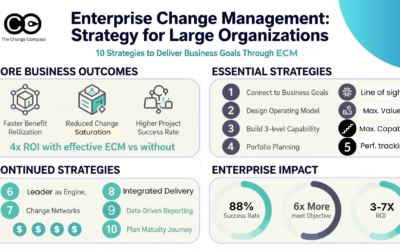Change governance maturity varies widely across organizations – from those with established PMOs and formal governance structures to others that rely on existing operational and executive forums without formal change governance setups. Change managers must tailor their influence strategies to fit this maturity spectrum while empowering governance that supports change transformation success. Here we outline practical tips and approaches relevant whether you operate within high-maturity governance or in environments still building foundational capabilities.
1. Leverage Governance Dexterity – Adapt to Your Maturity Context
For organizations with mature PMOs and governance:
- Encourage maintaining cadence with purpose – weekly flash checks for quick updates, monthly value reviews to keep benefits front of mind, and quarterly strategic moments for big-picture alignment and celebration. This reduces fatigue and keeps governance tightly connected to business outcomes.
- Share frameworks that provide agility within formal governance so cadence remains flexible without diminishing control. For example, leverage agile change management principles to:
- Embedding lightweight, iterative review processes that emphasize timely feedback and rapid decision-making without heavy documentation or unnecessary meetings.
- Using tools like RACI matrices and decision-rights grids to clarify who has authority and responsibility, so governance can flex in how often or how deeply it engages, but never loses accountability.
- Allowing governance forums to scale their activity up or down based on change program phase, risk, or complexity, rather than sticking to a rigid calendar or process.
For less mature organizations without dedicated governance forums:
- Propose leveraging existing operational or executive forums to introduce lightweight governance rhythms that do not overburden people. For example, brief monthly check-ins during established leadership meetings or quarterly presentation slots to highlight change progress and risks.
- Use simple tools like cadence checklists or short-status emails tailored for existing leaders who may not be change specialists. Position these rhythms as value-adds to existing meetings to gain buy-in.
Practical tips:
- Offer templates for flash checks and value meetings that can be easily integrated into the existing meeting culture.
- Advocate building urgency without burnout by linking cadence to visible outcomes rather than just process compliance.
2. Drive Enterprise PMO & Portfolio Alignment – Fit Your Organization’s Governance Model
For organizations with established PMOs:
- Partner closely with PMO and portfolio managers to ensure change work is fully integrated. Act as a bridge between change activities and portfolio governance to align priorities effectively.
- Encourage shared dashboards that combine project and change metrics, giving leadership clarity on both deliverables and adoption risks.
- Advocate for change governance representation in portfolio decision forums to embed change risk and opportunities in prioritization.
For organizations without formal PMOs:
- Identify operational units or executive groups with portfolio oversight responsibilities and seek informal relationships with key members.
- Suggest practical ways to leverage existing governance bodies for change oversight by embedding change highlights in their agenda.
- Provide simple portfolio mapping or status tools that don’t require heavy infrastructure but help visualize transformation across initiatives.
Practical tips:
- Offer to co-create change input templates that non-PMO forums can use to review change risk, interdependencies and impact.
- Share success stories illustrating how integrated PMO-change governance drives consistent messaging and prioritization.
3. Shape Executive Reporting – From Insight to Influence
For organizations with mature reporting processes:
- Help refine executive dashboards by ensuring a balance between project status and change readiness/adoption metrics.
- Coach change teams to translate data into compelling narratives that highlight risks, opportunities, and decision points.
- Push for reporting formats that enable proactive governance action rather than reactive compliance.
For organizations with limited or no formal executive reporting:
- Influence existing executive communications by proposing change-related content for leadership newsletters, briefings, or standing meeting updates.
- Develop concise, jargon-free reports that fit into current executive reading habits and spotlight what matters most.
- Advocate for simple visual reporting tools, e.g., impact bar charts or risk registers that executives can quickly interpret.
Practical tips:
- Provide sample executive report templates tailored for different maturity levels.
- Offer coaching sessions on storytelling with data to change teams who may be new to executive reporting.
4. Champion Scenario Planning to Build Resilience
Scenario planning is a powerful tool that helps organizations prepare for uncertainty by imagining multiple plausible futures, assessing their impact, and planning appropriate responses. For change practitioners, influencing scenario planning within change governance is critical to making transformation resilient to volatile conditions and unexpected challenges.
For organizations with mature change governance and PMO structures:
- Advocate for formal inclusion of scenario planning in governance cycles, such as quarterly strategy reviews or portfolio risk assessments.
- Collaborate with PMO, risk, and strategy functions to develop integrated scenario frameworks that tie external uncertainties with change delivery risks.
- Use structured tools and templates to develop 2-3 distinct scenarios based on critical uncertainties impacting change programs (e.g., regulatory shifts, technology adoption rates, cost pressures, market dynamics).
- Ensure scenario outputs include clear implications for adoption risk, resource allocation, and contingency triggers to inform governance decision-making.
For organizations with limited formal governance:
- Promote lightweight scenario planning approaches that can fit into existing forums or leadership discussions without requiring new committees.
- Facilitate workshops or brown bag sessions with key stakeholders to brainstorm “what-if” scenarios that highlight risks and opportunities in their own language.
- Use simple scenario templates capturing scenario description, key assumptions, impacts, and early warning signs to keep the process manageable and relevant.
- Position scenario planning as a practical alternative to reactive firefighting, reinforcing its value for anticipating and mitigating disruption to change efforts.
Practical Tips for All Maturity Levels:
- Focus scenario development on a small number (2-3) of meaningful scenarios that highlight material differences rather than an exhaustive list.
- Use scenario planning to identify robust strategies that perform well across multiple futures, reducing overcommitment to any single pathway.
- Regularly review and update scenarios to reflect new information and organizational shifts, embedding this as a governance cadence.
- Engage diverse viewpoints in scenario sessions to challenge assumptions and broaden organizational readiness.
Example Scenario Planning Framework (in brief):
| Step | Action |
| Identify Key Drivers | Pinpoint external and internal uncertainties: economic, technological, regulatory, organizational |
| Develop Scenarios | Build 2-3 narrative futures exploring combinations of drivers |
| Analyze Impact | Assess effects on change timelines, adoption, resources |
| Define Responses | Create contingency plans and decision points |
| Monitor & Update | Track relevant indicators and review scenarios regularly |
5. Clarify Decision Making Authority, and Risk Appetite – Influence Without Direct Control
One of the most frequent governance pitfalls in transformation is unclear decision rights, leading to duplicated effort or “decision limbo,” which stalls progress. Change practitioners can significantly influence clarity around decision making even when not formally leading governance forums.
For organizations with high governance maturity:
- Advocate for or refine delegation charters that grant clear authority boundaries across change roles and governance tiers.
- Promote use of decision-rights grids paired with RACI matrices, documenting decisions by type, level, and role to eliminate ambiguity.
- Encourage articulation of organization’s risk appetite in governance policies to guide decisions on escalation and investment.
- Work with governance leads to socialise these tools regularly and embed them in operational processes.
For organizations with emerging or informal governance:
- Educate stakeholders about the value of explicit decision clarity through workshops or short guides.
- Propose simple RACI templates tailored for key initiatives to clarify roles on responsibility, accountability, consultation, and information sharing.
- Introduce a basic decision-rights grid to categorize decisions (routine operational, tactical, strategic) and assign decision tiers even if informally.
- Frame this work as risk mitigation: reducing delays and confusion frees leaders to focus on strategic priorities.
Practical Tips Across Maturity Levels:
- Develop easy-to-use templates and cheat sheets for RACI and decision grids to distribute widely.
- Use storytelling and real case examples to illustrate consequences of unclear decision-making (e.g., project delays, duplicated efforts).
- Regularly revisit and update decision frameworks as governance evolves, ensuring ongoing relevance.
- Encourage governance sponsors to visibly support and enforce these clarity tools.
6. Define and Promote Clear Escalation Paths
Clear escalation paths empower teams to raise concerns timely and guide issues to the appropriate governance levels without clogging decision forums or escalating unnecessarily. Change managers can champion and embed escalation discipline through influence, education, and practical tools.
For organizations with mature governance:
- Collaborate with governance teams to map all escalation routes related to change risks, decisions, and resource conflicts.
- Promote communication plans ensuring every contributor understands when and how to escalate – down to roles and contact points.
- Incorporate escalation workflows into governance charters, RACI matrices, and decision-rights grids to reinforce paths.
- Champion periodic training or refresh sessions aligned with governance cadence to maintain escalation readiness.
For organizations with limited governance forums:
- Identify natural escalation points in existing leadership or operational forums and propose embedding change escalation protocols there.
- Provide clear documentation and quick-reference escalation flow diagrams for frontline teams and managers.
- Coach teams and middle managers on recognizing escalation triggers and the best mode of communication to avoid bottlenecks.
- Frame escalation discipline as a way to safeguard both operational pace and leadership bandwidth.
Practical Tips Usable in All Environments:
- Use visual flowcharts to depict escalation paths, making them highly accessible and easy to recall.
- Set guidelines on what kinds of issues require escalation vs. local resolution to reduce unnecessary escalations.
- Promote handling low-level risks swiftly through informal escalation while preserving formal routes for major decisions.
- Encourage transparency in escalation outcomes to build trust and learning across the organization.
7. Invest in Stakeholder Education & Engagement – Be the Governance Evangelist
The success of change governance depends as much on people’s understanding and buy-in as on structures and processes. Senior change managers have a vital role in educating stakeholders, increasing governance literacy, and fostering engagement – especially in organizations where governance maturity varies or formal forums are limited.
For organizations with mature governance:
- Develop formal stakeholder education programs that provide regular training on governance roles, decision frameworks, escalation processes, and how governance aligns with transformation outcomes.
- Use targeted communications that frame governance benefits in terms relevant to each stakeholder group – showing “what’s in it for them.”
- Implement forums like governance clinics or Q&A sessions where stakeholders can clarify their roles, raise concerns, and share governance success stories.
- Collaborate with governance sponsors to visibly champion these initiatives to prevent stakeholder fatigue and increase participation.
For organizations with emerging or informal governance:
- Start small with bite-sized governance literacy sessions embedded in existing communication channels such as team meetings or newsletters – keep it jargon-free and highly practical.
- Translate complex governance concepts into everyday language, storytelling, and case examples that resonate with different stakeholder groups.
- Identify and coach governance champions within teams who can help cascade key messages informally.
- Use tools such as quick reference guides, checklists, and simplified RACI matrices to embed governance knowledge across operational levels.
Practical Tips Across All Maturity Levels:
- Conduct a stakeholder governance literacy audit to understand knowledge gaps and tailor education efforts accordingly.
- Develop short governance video clips or Q&A hosted by trusted leaders explaining key governance principles and benefits.
- Regularly gather feedback through surveys or informal conversations to refine education efforts ensuring they meet stakeholder needs.
- Emphasize the connection between good governance practices and the successful delivery of benefits, reducing resistance and increasing advocacy.
Change governance is often viewed as a formal, top-down function but, as change managers, you are uniquely positioned to influence its design and execution regardless of your direct access to governance forums. The key lies in adapting your approaches to the maturity and structure of your organization’s governance, leveraging existing forums and networks, and focusing on clear communication, collaboration, and practical tools.
By championing governance dexterity, bridging PMO and portfolio governance gaps, shaping executive reporting, embedding scenario planning, clarifying decision rights, defining escalation paths, and investing in stakeholder education, you create a foundation where governance truly supports transformation velocity, clarity, and resilience. You also create a strategic change contribution to help the organisation reach its transformation benefit goals.
Tools & Templates for Influence and Education
- Cadence Checklists: Ready-to-use templates to propose weekly flash checks, monthly value meetings, and quarterly strategic reviews tailored for different governance forums and maturity.
- Sample RACI Matrix & Decision-Rights Grid: Simplified versions that can be adapted for routine and strategic decisions, supporting role clarity and authority distribution.
- Escalation Flow Diagram: Visual maps suitable for team briefings and leader coaching in both formal and informal governance contexts.
- Stakeholder Education Plan Outline: A scalable framework for assessing needs, designing education content, and measuring engagement impact.






